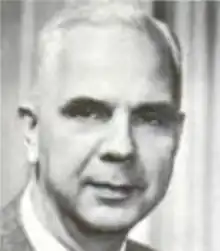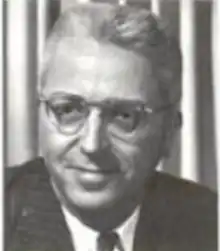 Official seal | |
| Agency overview | |
|---|---|
| Formed | March 3, 1871 |
| Dissolved | January 1, 1978 |
| Superseding agencies | |
| Jurisdiction | U.S. federal government |
The United States Civil Service Commission was a government agency of the federal government of the United States and was created to select employees of federal government on merit rather than relationships. In 1979, it was dissolved as part of the Civil Service Reform Act of 1978; the Office of Personnel Management and the Merit Systems Protection Board are the successor agencies.
History
On March 3, 1871, President Ulysses S. Grant signed into law the first U.S. civil service reform legislation, which had been passed by Congress.[1] The act created the United States Civil Service Commission, that was implemented by President Grant and funded for two years by Congress lasting until 1874. However, Congress which relied heavily on patronage, especially the Senate, did not renew funding of the Civil Service Commission.[2] President Grant's successor, President Rutherford B. Hayes requested a renewal of funding but none was granted.
President Hayes' successor, James A. Garfield, advocated Civil Service reform. His efforts against the spoils system, also known as patronage, were cut short after he was assassinated by Charles J. Guiteau.
Pendleton law
President Garfield's successor, President Chester A. Arthur, took up the cause of Civil Service reform and was able to lobby Congress to pass the Pendleton Civil Service Reform Act in 1883. The Pendleton law was passed in part following a public outcry over the assassination of President Garfield. The Pendleton Act renewed funding for the Civil Service Commission and established a three-man commission to run Civil Service whose commissioners were chosen by President Arthur. The Civil Service Commission administered the civil service of the United States federal government.[3] The Pendleton law required certain applicants to take the civil service exam in order to be given certain jobs; it also prevented elected officials and political appointees from firing civil servants, removing civil servants from the influences of political patronage and partisan behavior.[4] President Arthur and succeeding Presidents continued to expand the authority of the Civil Service Commission and federal departments that the Civil Service was covered. The Civil Service Commission, in addition to reducing patronage, also alleviated the burdensome task of the President of the United States in appointing federal office seekers.
Under the Commission Model, policy making and administrative powers were given to semi-independent commission rather than to the president. Reformers believed that a commission formed outside of the president’s chain of command would ensure that civil servants would be selected on the basis of merit system and the career service would operate in a politically neutral fashion. Civil Service Commissions typically consisted of three to seven individuals appointed by the chief executive on a bipartisan basis and for limited terms. Commissioners were responsible for direct administration of personnel system, including rule-making authority, administration of merit examinations, and enforcement of merit rules.
1953 Executive Order
On April 27, 1953, President Eisenhower issued Executive Order 10450, which banned gay men and lesbians from working for any agency of the federal government, including the United States Civil Service Commission.[5] It was not until 1973 that a federal judge ruled that a person's sexual orientation alone could not be the sole reason for termination from federal employment, and not until 1975 that the United States Civil Service Commission announced that they would consider applications by gays and lesbians on a case by case basis.[6]
1978 reorganization
Effective January 1, 1978, functions of the commission were split between the Office of Personnel Management and the Merit Systems Protection Board under the provisions of Reorganization Plan No. 2 of 1978 (43 F.R. 36037, 92 Stat. 3783) and the Civil Service Reform Act of 1978. In addition, other functions were placed under jurisdiction of the Equal Employment Opportunity Commission (EEOC), the Federal Labor Relations Authority (FLRA) and the Office of Special Counsel (OSC).
Chairmen of the commission
| Image | Name | From | Until |
|---|---|---|---|
 |
George W. Curtis[7] | January 1, 1872 | January 1, 1874 |
 |
Dorman B. Eaton | Mar 9, 1883 [8] | Nov 1, 1885 (resigned)[9] |
 |
Alfred P. Edgerton | Nov 9, 1885 [10] | Feb 9, 1889 (removed)[10] |
| Charles Lyman | May 13, 1889 [12] | Dec 15, 1893 (resigned)[13] | |
 |
John R. Procter | Dec 15, 1893 [13] | Dec 12, 1903 (died)[14] |
 |
John C. Black | Jan 17, 1904 [15] | Jun 10, 1913 (resigned)[16] |
| John A. McIlhenny | Jun 12, 1913 [17] | Feb 28, 1919 (resigned)[18] | |
 |
Martin A. Morrison | Mar 13, 1919 [18] | Jul 14, 1921 (resigned)[19] |
 |
John H. Bartlett | Jul 15, 1921 [19] | Mar 12, 1922 (resigned)[19] |
 |
William C. Deming | Mar 1, 1923 [20] | Feb 6, 1930 (resigned)[21] |
 |
Thomas E. Campbell | Jul 11, 1930 [22] | c. 1933 (resigned) |
.jpg.webp) |
Harry B. Mitchell | May 19, 1933 [23] | Feb 26, 1951 (resigned)[24] |
 |
Robert Ramspeck | Mar 16, 1951 [25] | Dec 31, 1952 (resigned)[26] |
_1957.jpg.webp) |
Philip Young | Mar 23, 1953 [27] | Feb 11, 1957 (resigned)[28] |
.jpg.webp) |
Harris Ellsworth | Apr 18, 1957 [29] | Feb 28, 1959 (resigned)[29] |
 |
Roger W. Jones | Mar 10, 1959 [30] | Jan 4, 1961 (resigned)[31] |
 |
John W. Macy | Mar 6, 1961 [32] | Jan 18, 1969 (resigned)[33] |
| Robert E. Hampton | Jan 18, 1969 [33] | c. 1977[34] | |
 |
Alan K. Campbell | January 2, 1979 | January 20, 1981 |
See also
References
- ↑ "Civil Service Commission", in Landmark Legislation, 1774-2002: Major U.S. Acts and Treaties, ed. by Stephen W. Stathis (Congressional Quarterly Press, 2003) p107
- ↑ Brands (2012), pp. 543-544
- ↑ "American President: Key Events in the Presidency of Chester A. Arthur". Archived from the original on 2010-12-17.
- ↑ Creating America: A History of the United States, Rand McNally, p 238 (2003)
- ↑ 04/27/2012 3:48 pm EDT (2012-04-27). "April 27, 1953: For LGBT Americans, a Day That Lives in Infamy | Josh Howard". Huffingtonpost.com. Retrieved 2015-06-25.
{{cite web}}: CS1 maint: numeric names: authors list (link) - ↑ "Cold War, Lavender Scare, and LGBTQ+ Activism". National Park Service. US Department of the Interior. Retrieved 2 January 2023.
- ↑ Smith (2001), p. 589
- ↑ Foulke, W. D. Fighting the spoilsmen: reminiscences of the civil service reform movement (New York: G.P. Putnam's Sons. 1919), p.8
- ↑ Cleveland, Grover. Accepting Letter of Resignation of Dorman B. Eaton in The Writings and Speeches of Grover Cleveland, ed. George F. Parker (New York: Cassell Publishing Company, 1892), p.46
- 1 2 Fourth Report of the United States Civil Service Commission (Washington: Government Printing Office. 1888) pp. 120-121
- R.P. van Riper, 1958. History of the United States Civil Service, Row, Peterson & Co., 1958
- ↑ Trying The Charleston, "New York Times", May 14, 1889
- 1 2 Procter Succeeds Lyman, "The Daily Argus News" (Crawfordsville, Indiana), Dec 15 1893
- ↑ ''Twentieth Annual Report of the United States Civil Service Commission (Washington: Government Printing Office, 1904) p. 7.
- ↑ Gen. Black Takes The Oath, "New York Times", Jan 17, 1904
- ↑ Thirty-First Annual Report of the United States Civil Service Commission (Washington: Government Printing Office, 1915) p. 116.
- ↑ McIlhenny Heads Civil Service, "New York Times", Jun 13, 1913
- 1 2 Thirty-Sixth Annual Report of the United States Civil Service Commission(Washington: Government Printing Office, 1919) p. xxvii
- 1 2 3 Thirty-Ninth Annual Report of the United States Civil Service Commission(Washington: Government Printing Office, 1922) p. 121
- ↑ The U.S. Civil Service Commission, "Congressional Digest", Vol II. No. 7 (April 1923), p. 198
- ↑ Hoover, Herbert. Letter Accepting the Resignation of William C. Deming as President of the Civil Service Commission in "Public Papers Of The Presidents Of The United States" (Washington: Government Printing Office, 1976)
- ↑ Civil Service Head Takes Oath, "The Hartford Courant" (Hartford, Connecticut), Jul 11, 1930
- ↑ Politics And Politicians, "Gazette And Bulletin" (Williamsport, Pennsylvania), May 20, 1933
- ↑ Ramspeck Is Named Civil Service Head, "The Day" (New London, Connecticut), Feb 27, 1951
- ↑ Ramspeck Takes Oath For Commission Post, "The Spokesman-Review" (Spokane, Washington), Mar 17, 1951
- ↑ Civil Service Chief Quits, Wins Praise, "Toledo Blade" (Toledo, Ohio), Jan 1, 1953
- ↑ Eisenhower Pledges To Rid Civil Service Of All Incompetents, "Florence Times" (Florence, Alabama), Mar 23, 1953
- ↑ Two Quit CSC, "Reading Eagle" (Reading, Pennsylvania), Feb 11, 1957
- 1 2 "Ellsworth, Matthew Harris". Biographical Directory of the United States Congress. Senate Historical office and House Legislative Resource Center.
- ↑ Roger Jones Becomes Head of Civil Service, "The Hartford Courant" (Hartford, Connecticut), Mar 10, 1959
- ↑ Kennedy, Farm Bosses Tackle Issue, "The Miami News" (Miami, Florida), Jan 5, 1961
- ↑ Macy Serves First Month In Federal Post for Free, "The Hartford Courant" (Hartford, Connecticut), Mar 5, 1961
- 1 2 Nixon Names Three to Policy Positions, "The Los Angeles Times" (Los Angeles, California), Jan 18, 1969
- ↑ "Robert E. Hampton, Member and Chairman, U.S. Civil Service Commission; Member and Chairman, Federal Labor Relations Council: Papers 1960-77". Gerald R. Ford Library-Guides. June 1989. Archived from the original on 2011-07-01. Retrieved 2011-02-09.